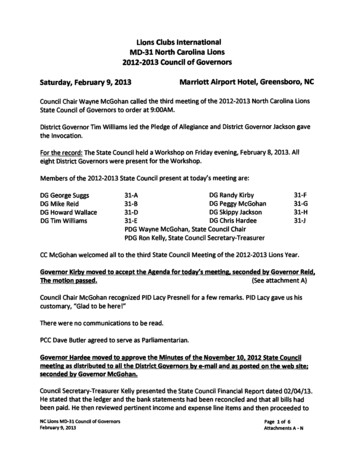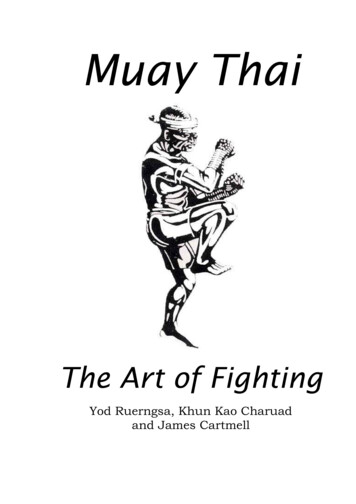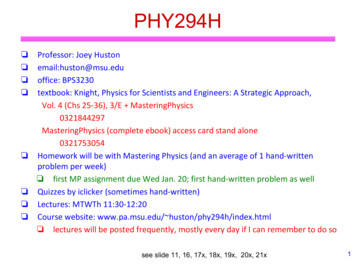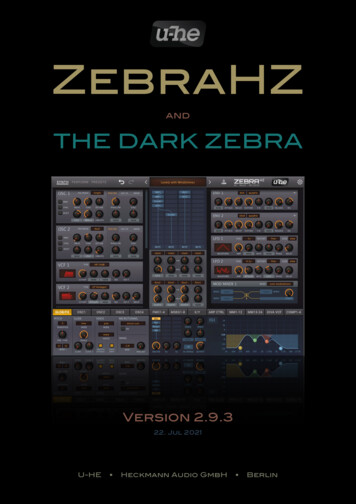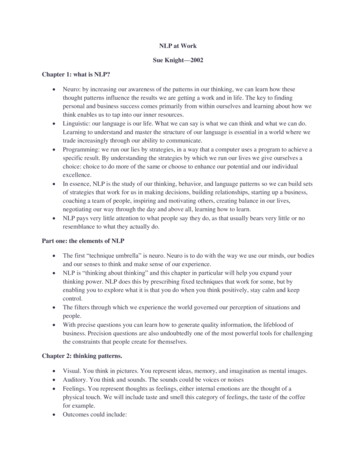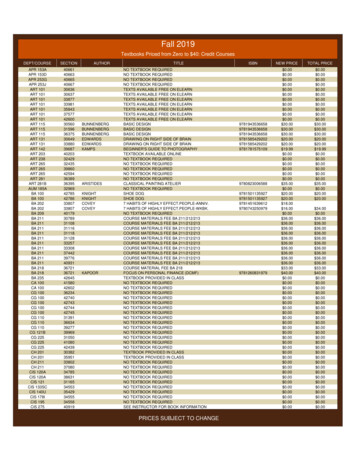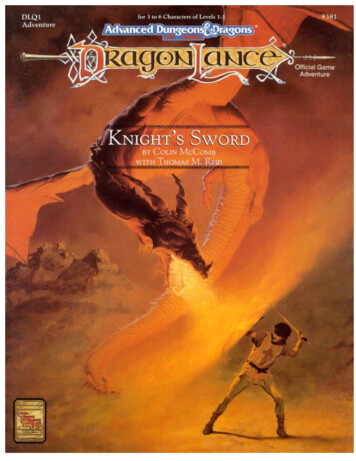
Transcription
Knight s SwordBy Colin McCombwith Thomas M. ReidTable of ContentsIntroduction . . . . . . . . . . . . . . . . . . . . . . .Tips for the New DM . . . . . . . . . . . . . . . .A Few Words AboutDRAGONLANCE Adventures . . . . . . .Background . . . . . . . . . . . . . . . . . . . . . . .The Knighthood . . . . . . . . . . . . . . . . . . . .The Tests . . . . . . . . . . . . . . . . . . . . . . . . . . .Diversions . . . . . . . . . . . . . . . . . . . . . . . . .The Theft . . . . . . . . . . . . . . . . . . . . . . . . .The Investigation . . . . . . . . . . . . . . . . . . .22345791011The Chamber of Paladine . . . . . . . . . . . . 14The Road to Solanthus . . . . . . . . . . . . . . . 19The Traitor? . . . . . . . . . . . . . . . . . . . . . . . 21Visiting Solanius . . . . . . . . . . . . . . . . . . . . 23The True Traitor . . . . . . . . . . . . . . . . . . . 24The Return . . . . . . . . . . . . . . . . . . . . . . . 25Epilogue . . . . . . . . . . . . . . . . . . . . . . . . 26Major NPCs . . . . . . . . . . . . . . . . . . . . . . . 27Magical Items . . . . . . . . . . . . . . . . . . . . . . 29Pregenerated Characters . . . . . . . 15-18, 31Credits:Design: Colin McComb withThomas M. ReidEditing: Thomas M. ReidCover Art: Robh RuppelInterior Art: Thomas YeatesCartography: DieselProduction: Sarah FeggestadTypography: Angelika LokotzTSR, Inc.POB 756Lake Geneva, WI 53147U.S.A.Gnomish Death Machine and Some GoodAdvice: David J. ZenzSpecial Thanks: Karen S. Boomgarden, JeffDettweiler, Mike Edwards, Harold Johnson, Rob King, Brad “Sun Dog” Matheson, Kevin Pohle, Laddie Voslar, James M.Ward, and David WiseTSR Ltd.120 Church End, Cherry HintonCambridge CB1 3LBUnited KingdomRandom House and its affiliate companies have worldwide distribution rights in the book trade for English language products of TSR, Inc.Distributed to the book and hobby trade in the United Kingdom by TSR Ltd.Distributed to the toy and hobby trade by regional distributors.ADVANCED DUNGEONS & DRAGONS, AD&D, and DRAGONLANCE are registered trademarks owned by TSR, Inc.DUNGEON MASTER, DM and the TSR logo are trademarks owned by TSR, Inc.This material is protected under the copyright laws of the United States of America. Any reproduction or other unauthorized use of thematerial or artwork contained herein is prohibited without the express written consent of TSR, Inc.Printed in U.S.A.Copyright 1992 TSR, Inc. All Rights Reserved9381ISBN 1-56076-421-X9381XXX1501Permission granted to photocopy or print this product for personal use.
IntroductionWelcome to the world of Krynn. Here, on thecontinent of Ansalon, the age-old struggle of Goodagainst Evil continues unchecked. Bands of heroesbattle forces of darkness, hoping to gain footholdsfor the side of light. Ansalon is a land of challenge,one in which fortune can make or break any adventurer. Welcome to Ansalon, the land of theDragonlance.This module is intended for characters of levels1 through 3. It can be used as an adventure for introducing players to the world of Krynn. Its primary purpose, however, is to ease a beginningDUNGEON MASTER (or DM ) into his or herjob. While the adventure is written with these beginners in mind, this does not preclude use bymore experienced DMs. Players should read nofurther in this book, unless they want to spoil theadventure for themselves. It is intended for theDM’s eyes only.Most DMs should have already played the gameand should be familiar with its terminology andprocedures. This time, however, the burden ofcreating an enjoyable evening rests on the shoulders of aspiring DMs. The following hints will easethe beginner into his or her job.Tips for the new DM Being a DM is a big task. Not only is the DM responsible for populating the campaign, runningthe NPCs and monsters, creating the maps, remembering vast quantities of rules, and effectivelydescribing each setting, but he or she also mustensure that the players have a good time. This is atall order, especially for those who have neverdone it before. Many times it will seem like athankless job, especially when the players disagree with decisions the DM makes.Nevertheless, there are good points to being aDM, despite the numerous headaches associatedwith the job. The satisfaction of providing the players with a memorable experience ranks high onthe list. Creating an adventure that engrosses theplayers’ and the DM’s imaginations is a vastly satisfying thing. Being a DM is definitely a labor oflove, but is well worth the time and effort invested,and soon it will become second nature.What follows is advice on how to referee effectively, notes on standard refereeing practices, anda few words of caution for the beginning DM.While wearing the mantle of DM, you must befair and impartial at all times. No matter how irritating a player becomes, it is imperative that theDM not allow personal preferences to interferewith the smooth flow of the game. Obnoxiousplayers will eventually behave, or else they willquit playing; poor social graces tend to cause ineptplaying and the death of favored characters.2Likewise, don’t let the players get away with toomuch. Running player characters (or PCs) doesnot mean they should receive extraordinary treatment from the non-player characters (NPCs). Theplayer characters and the NPCs are citizens in theworld and nothing more. They may be heroes, butthey must obey the same laws as other citizens.Since the players do control heroes, they will occasionally try something that is “exceptionally heroic” (nearly impossible). At times like these, theDM’s first reaction is just to say “No” and be donewith it. However, since these are heroes, they often can accomplish things that ordinary mortalscould not. Thus, the wise DM will allow attemptsat these actions.Simply determine how difficult a proposedaction might be and have the player roll a d20against an appropriate ability score for it. Forsomething extremely improbable (jumping acrossa 30-foot chasm while dressed in full plate armor),the die modifier might be as much as -10, if theDM feels it is warranted. Never deny any actionoutright; always give the PCs a chance.Don’t try to railroad the players into one courseof action, either. If they don’t want their PCs to goon an adventure, cajoling them will not help matters. The DM may have to explain what it means tobe a hero, but no DM should ever control a player’s actions. The DM might want to try offering thesame adventure in different packages, through different NPCs, a few separate times. If none of thesetempts the players, try to work the adventure insomeplace else, in the midst of another. Nothing ismore irritating to a player than a DM who constantly tries to dictate the actions of the party.Remember, the DM is there for both his or herown and the players’ pleasure. If one or both ofthese groups is not enjoying itself, the point of thegame is lost. Only if both groups can cooperate tocreate a shared vision is the game successful. TheDM should always strive to make sure that fun ishad by all.One very important thing to remember is that theDM has the final word on all rules disputes. TheDM shapes the game, and any rules that do not coincide with the DM’s style should be ignored. This isnot to suggest that all rules simply be discarded, butrather that they be modified as the DM sees necessary. While the players may input their opinions asto the form of the rules (usually in their favor), onlythe DM decides. They may decide to take on theresponsibility of DM themselves.Also, remember that this is just a game. It isnothing over which to destroy real-world friendships. All disputes should be handled amicablyand fairly. If any participants cannot deal with theirproblems in a more mature fashion, perhaps thegame ought to be delayed until the problem canbe resolved.This is only a small list of suggestions for moreeffective refereeing. For a more comprehensiveview of the task, consult DMGR 1, the Campaign
Sourcebook and Catacomb Guide. This book provides insight into problems that face every DM, aswell as suggested answers to those problems.Some refereeing conventions include the use ofboxed text and abbreviations for monsters andNPCs. Text surrounded by a box means that theDM is to read or paraphrase the enclosed text tothe players. Any text not so surrounded is information for the DM only, to be given to the players ashe or she sees fit. This information may or may notbe discovered by the players’ characters as theyexamine the encounter. Whether they do or notshould depend purely on their actions.When the PCs encounter monsters, the typicalformat of the presentation is as follows:Monster Name (Number): lnt ; AL ; AC ; MV ;HD; hp; THAC0; #AT; Dmg; SA; SD; MR; SZ;ML; XP each.Int Intelligence; AL alignment; AC ArmorClass; MV movement; HD Hit Dice; hp hitpoints; THAC0 roll to hit AC 0; #AT numberof attacks/round; Dmg damage of each attack;SA and SD special attacks and defenses; MR magic resistance; SZ size; ML morale; XP experience points for defeating the creature(s).Example:Skeletons (3): Int Non; AL N; AC 7; MV 12; HD 1;hp 8, 7, 3; THAC0 19; #AT 1; Dmg 1d6 (weapon);SD special; MR special; SZ M; ML special; XP 65.Non-player characters are presented in much thesame way. If they are not major NPCs (who oftenwarrant an entire character sketch), their presentation is as follows:Tanis Half-Elven: AL NG; AC -3; MV 12; F10; hp79; THAC0 11; #AT 3/2; Dmg by weapon type; S16, D 16, C 12, I 12, W 13, Ch 15; plate mail 2,shield 2, long sword 2Please note that the class abbreviation follows themovement rating. The abbreviations are:B BardF Fighter D DruidKS Knight ofM MageR RangerP PaladinI IllusionistSolamniaT ThiefC ClericA final note: Every DM is advised to carefully readthrough every adventure he or she runs. Nothingdisrupts the flow of an adventure more than a DMwho must constantly flip through the text to seewhat’s going on. If a villain has laid plans, it is imperative that the DM know what those plans are.Otherwise, the adventure becomes an exercise indisruption and incoherence. The DM should havean idea about the relative challenge to the playerspresented by the adventure and be able to adjustthe difficulty of the encounters accordingly. If thecharacters seem too powerful for an adventure,make the encounters more difficult. If they are tooweak, make the encounter simpler. A wellbalanced game is essential. Always read throughthe adventure at least once!A Few Words AboutDragonlance AdventuresArmed with all of this information, the beginningDM now prepares to charge into the fray. But wait!The DM must also learn some essentials about theworld of Krynn-things that separate it and make itunique from all other known worlds.A proper DRAGONLANCE campaign bases itself around the struggle of good versus evil andaround the characters’ relationships in and with theworld. Not every adventure is an earth-shakingevent, destined to alter the history of Krynn. However, every one of them should embody the struggle which characterizes the epic quality of theDRAGONLANCE world. While most campaignsare simply a collection of adventurer’s stories, theDRAGONLANCE saga draws these stories togetherinto a coherent whole of epic proportions.DRAGONLANCE adventures promote thepower of truth over falsehood, justice over injustice, and Good over Evil. Good actions will generally be rewarded with blessings, while graveconsequences arise from evil actions. While evilmay temporarily gain a foothold, good shouldeventually win out.DRAGONLANCE adventures tend to focus lesson the combative aspects of the AD&D game, andmore on thinking and role-playing. Interpersonalrelationships are a key facet of DRAGONLANCEplay.The world of Krynn itself is markedly differentfrom others. Any DM who plans adventures withinKrynn should be aware of these differences. Thefeatures which are most distinct include the newraces, the moons and their influences on magic,and the Knights of Solamnia. The races unique toKrynn include the kender, draconians, and minotaurs. Each of these lends a unique flavor to thegame. Minotaurs appear outside of Krynn, butthey are a lesser race elsewhere.The effectiveness of magic on Krynn relies onthe three moons. When one’s “patron moon”wanes, so does the efficacy of one’s magic. TheDM must pay careful attention to the phases of themoon where magic is involved.The Knighthood of Solamnia is the enforcingarm of good. Its goals are not so much to win moreland and glory for good, but to stem the rising tideof evil on Ansalon. The knights are the main forcefor chivalry, law, and goodness on this continent,and they constantly seek to keep the people awareof the knightly ideals,3
BackgroundAt the height of the War of the Lance, the dragonarmies besieged the High Clerist’s Tower nearthe city of Palanthus, where the knighthood hadentrenched itself. After a long wait, a large force ofseasoned knights, led by crazed Lord DerekCrownguard, stormed forth from the Tower. However, Dragon Highlord Kitiara had planned forthis, and the dragonarmy crushed the battalion.Convinced that this spelled the end of theknights, Kitiara’s army advanced on the HighClerist’s Tower. Only Sturm Brightblade and hisforce of untested knights held Vingaard Passagainst the dragonarmies, while an elven princessand her discovery of a dragon orb stood betweenthe dragonarmies and their rape of Palanthas.Sturm Brightblade sacrificed his life in order tobuy time for the remaining knights and PrincessLaurana, precious time needed to master thepowers of the orb. His death purchased that time,and more importantly, caught the hearts of thepeople throughout Krynn. It paved the way for arestructuring of the Orders of the Knights of Solamnia. The knights realized that they had beenliving according to ancient rules that no longerheld any meaning, to a Measure that could neithercontain nor prescribe the honor of a true knight.It took Brightblade’s death, as well as the inglorious and foolish assault of Derek Crownguard, tomake the knighthood realize that its priorities layscattered. After the War of the Lance, the knighthood honored Sturm Brightblade’s bravery anddedication to the orders of the knighthood.The knights laid his body in state in the Chamberof Paladine, the burial chambers beneath the HighClerist’s Tower. Here, with his armor and sword arrayed about him in honor, he lay peacefully andundisturbed by those who came for inspiration.His tale has been told and re-told, his bravery andintegrity against the corruption of the old, stagnantknighthood seeming to grow with each re-telling.And with each telling, the reforms sweeping theorders gain even more momentum.Most support the changes, but there are somewho work long and hard to make sure the oldways continue to favor them. It appears that theseopponents of change will stop at nothing to makesure that their positions remain unharmed.This adventure is designed for three to six characters of beginning level. At least one PC must beaspiring to the knighthood (although none shouldhave succeeded, as yet). The rest can be a mixtureof other races and classes, but each player oughtto remember that the knights focus strongly onhonor. Dishonorable characters will hurt theknight-to-be’s chances of joining the Order. Eachplayer must abide by the restrictions of honor at alltimes. If existing characters are not available, theDM may assign the pregenerated characters foundin the center of this book.4Background for the DM Not everyone has felt joy in the exhaltation ofthe famed knight Sturm Brightblade and his heroics during the War of the Lance. Sir CharlesCrownguard, in his jealousy over the slighting ofhis cousin, means to defame the Orders. Unknown to anyone (including himself), Crownguardhas been corrupted by a magical item of great evil:the dagger of jealousy. He now plans to desecratethe final resting place of Brightblade and steal hissword (also called Brightblade), thus dishonoringthe knighthood.He means to accomplish this by hiring a thief tosteal the Brightblade. However, he does not knowthat the Order plans to spirit the sword away as oneof the tests, to see who among the candidates forknighthood has the sharpest mind. The knights, onthe other hand, have no idea that the Test will soonturn from a simulation to the real thing.What follows is the way the adventure is intended to run. If there are minor deviations, don’t worry. Make sure that any corrections made to thePCs’ path are subtle, and above all, do not forcethem to follow this path. If they go astray, useimagination to put them back on track.The likely flowof the adventureI. The player characters arrive at the HighClerist’s Tower.A. They proceed to the candidacy ceremony.B. An assassin makes his bid for Lord Guntharand is stopped.II. The Next Day.A. The knight-to-be begins his tests.B. The other PCs amuse themselves.III. The Brightblade is “stolen” by Lord Kellin Solanius as part of the tests.A. He leaves an important clue behind.B. He retrieves the blade just before the thiefhired by Crownguard arrives.C. Solanius travels to Solanthus.IV. The renegade Crownguard decides to kill Solanius for the sword.A. The PCs find the clues left by Solanius.B. The PCs arrive just in time to hear the dyingwords of Solanius.V. The PCs chase Crownguard and his thief to hiscastle, where they have a final battle. TheBrightblade breaks as Crownguard wields it.VI. The PCs retrieve the sword and must take it tobe reforged.VII. The heroes return in victory and their Solamnic companion is knighted.Naturally, no one can anticipate all of the thingsa player will do. Know the material, but always beprepared to wing it. Success in this is the measureof a true Dungeon Master.
The KnighthoodYou and your friends have ridden long andhard to reach the High Clerist’s Tower in timefor the Knightly Council. Sir Delson, a goodfriend of your father, has promised to sponsoryou during your petition to become a squire.You are eager to prove yourself, to join theranks of the gallant knighthood.The day is bright and clear, the early greeneryseeming to burst with life. Birdsong fills the airwith sweet notes, and the sky is blue and cloudless. The sun radiates its heat gently on the land.A gentle breeze caresses your faces as you ridefor the Tower. Along the road, both ahead ofand behind you, other candidates for knighthood also head to the Tower.The clear, bold notes of trumpets greet you asyou ride through the gates. The excitement feltby all is nearly palpable, electrifying the air.Once inside the large courtyard, young groomsrush forward to relieve you of your horses. Younotice guards stationed around the walls of theTower, keeping a vigilant eye on all comingsand goings. A harried-looking Knight of theCrown directs you toward the High CouncilHall on the 11th floor of the Tower. He introduces himself as Sir Rateliff, orders you to cometo him if you have any questions about the Tower or its inhabitants, and then tells you, in tonesthat brook no disobedience, to proceed thereat once.The knight is a descendant of the general whofaced Lord Soth at Dargaard Keep. He has beenassigned to see to the care and housing of the candidates, and to make sure that they know the wayto the High Council Hall. Due to the comparatively large volume of applicants, he currently haslittle time to spend answering questions. However, he is thoroughly knowledgeable about thelayout of the 16-story Tower. Although he is a softspoken individual, with a manner that seems moresuited to the Library in Palanthas than the knighthood, his fighting prowess and knowledge of battle tactics make him a fearsome foe in combat.Sir Rateliff: AL NG; AC 2; MV 9; KC7; hp 53;THAC0 14; #AT 3/2; Dmg 1d8 2 (long sword); S15, D 14, C 12, I 17, W 16, Ch 13; long sword 2If the characters do not follow Sir Rateliff’s directions, they are free to wander around the HighClerist’s Tower. However, they will then find themselves late to the Knightly Council. This willpresent some serious questions about the candidate’s dedication and the possibility that he is notresponsible enough to enter the knighthood. It also will blemish Sir Delson’s honor, since he agreedto sponsor someone unfit for the orders.Likewise, any of the hopeful knight’s companions who wish to explore the tower must restrainany larcenous tendencies. Even kender must holdback, for any misdeeds by the other PCs will reflect on their knightly friend. However, if any donot wish to watch the coming spectacle, they arefree to roam around the open parts of the tower. Ifthey so desire, they may even visit the Chamber ofPaladine, where the heroes of the knights lie instate. If they do so during the Knightly Council,nothing is amiss. It is only after the first day of thetests that the theft occurs.At the entrance to the High Council Hall, allof the candidates and their companions aregathered around two Knights of the Rose. Thecandidates are given white robes to wear overtheir other clothing. The knights then confiscateeveryone’s weapons, saying, “You won’t needthese in there.” After the candidates are suitablyattired, the knights lead everyone into the hall.If the PCs resist giving up their weapons, theknights will not allow them into the Hall. Onlyweapons which are obvious and openly worn willbe confiscated; a knight would not insult anyone’shonor by accusing him or her of concealing aweapon. The PCs are, however, allowed to weararmor into the hall.The spectacle in the hall is truly impressive.Rank upon rank of armored men stand beforeyou, gleaming in the sunlight streaming throughthe western window. The proud symbols of theknighthood decorate their armor, and the profusion of knights is almost overwhelming.Straight ahead of the candidates, in a clearedspace in the center of the room, is a mahoganytable with three chairs arrayed behind it. Thethree chairs are currently empty.The escorts lead the applicants to the seats arrayed before the mahogany table, while a pageshows the candidates’ friends to nearby seats.The tension among the applicants is intense, yetunsurprising, considering that the rulings madein this room will change the lives of those gathered today.The non-candidates among the PCs are seated inan area to the left of the table. There are severalseats available in the front row, just enough to seatall the PCs. They are located about 15 feet fromthe table. Filling most of the rest of the seats are thefamilies of other candidates. Sitting in the backrow is a beautiful blonde woman with intense blueeyes. Most of the males in the room are acutelyaware of her presence.After a slight wait (which will seem like an eternity to the candidates), the three High Knights enter.High Justice Gunthar Uth Wistan leads the procession into the room with a minimum of pomp. Evenso, their passage seems nearly mystical, like some-5
thing out of legend.They recite the Oath, “Est Sularus oth Mithas,”in unison. The three orders repeat it in turn. In unison, everyone in the room echoes it. Then, theknights begin to sing their hymn in celebration ofSpring. At last, the three High Knights sit. Afterthey are seated, the rest of the assemblage sits.The PCs may choose not to participate in theOath, as they are not knights and probably do notknow the words to the Knights’ Hymn. No one willthink worse of them if they do not.Immediately, Uth Wistan calls the council to order. He relates to them the knighthood’s news,which includes news of the dragonarmies (still secluded in Sanction), the infiltration of the armiesby the knights’ scouts (it goes well), the dispositionof the spoils of war (to go to needy families and thefamilies of the dead knights), and the rumors of atraitor in their midst. He dismisses this last, claiming that no one would be so foolish as to attemptto betray the knighthood.The hall is bright and warm. Normally, itwould be difficult to stay awake, but the excitement flowing through your veins keeps you alert. At long last, Lord Uth Wistan calls upon thesupplicants to stand.The other candidates rise immediately. The PCcandidate may or may not, as he so desires, butnot rising will be considered very rude and impertinent. This will color the knights’ perceptions ofthe PC for the rest of his existence.As Uth Wistan calls each candidate’s name, hereads the sponsor’s name as well. Both come forward to the table and present themselves to theaudience. If there is a question of a candidate’shonor based on his previous performance, that individual and his sponsor are ushered to a waitingroom. Although the candidates do not know it,this action has no bearing on their future in theknighthood. It is simply to let them know that theirunacceptable behavior has been noted, and it willnot be tolerated. About halfway through the list,the following event occurs. The assassin is sittingnext to the knight-to-be PC.Lord Uth Wistan calls out, “Grall Stonesword, sponsored by Sir Harald Karanus.” Aman sitting next to you rises and moves towardthe table. A knight in the back rises, looks at thecandidate, and with a note of alarm in his voicecalls out, “He’s not mine!”The mysterious supplicant explodes into motion, whipping a dagger from beneath his robesand leaping toward the table. All the knights areinstantly on their feet with a clash of armor.Some leap toward the table instantly, while others pause to draw their swords. It is obvious thatnone of them will make it to the table in time.The three High Knights rapidly push backwardin their chairs to move away from the man, but6Lord Uth Wistan trips over his. He falls on hisback, presenting an easy target for the assassin.Only the PCs and the other candidates are within reach of the assassin. Give the PCs the firstchance to react to the killer. If any of them hesitate, they should be left out of the initial (and crucial) round of action.Assassin: AL CE; AC 4; MV 9; F2; hp 15; THAC019; #AT 1; Dmg 1d4 1; S 16, D 15, C 12, I 12, W10, Ch 8; SA poison on dagger (roll a successfulsave vs. poison or death occurs in one day)The person with the best chance of halting theassassin before he reaches Lord Gunthar is theknightly candidate. If attacked, the man will defend himself with his dagger.If the PCs do not react immediately, the man willcontinue his mad dash toward the fallen HighKnight. After a moment of stunned disbelief, theother candidates will rush him but will be too lateto prevent him from reaching Gunthar Uth Wistan. The man will straddle the knight, and just before he can begin a fatal swing, he will be tackledby a mass of knights. In the confusion, the daggerwill scratch some NPC, who will go into immediate convulsions. Clerics rush in to tend to him. Finally, in the confusion, Sir Charles Crownguardwill run the assassin through with his sword. Hewill be apologetic, but the assassin will be dead.If the PCs act quickly, they can drag the assassindown themselves. Even if they are wounded by thepoisoned dagger, the clerics of Mishakal can neutralize the poison. Furthermore, if they manage tosuccessfully subdue the murderer, they will havethe gratitude of Uth Wistan and the rest of theknighthood. This will make achieving knighthoodmuch easier, and no questions arise about the PC’shonor later unless he is guilty of gross misconduct.If questioned, the assassin reveals that he is amember of the dragonarmies, sent by the DragonHighlords to assassinate Uth Wistan. During thequestioning, the man grovels like a worm, beggingfor his life. The knights throw him into a cell in thedungeons. If the PCs kill the man, the knights willbe rather displeased, but they will not grumbleovermuch if the PCs saved the life of Uth Wistan.After all the confusion, Uth Wistan continuesthe reading of the candidates. If the PCs saved hislife, Uth Wistan adds his name as a sponsor of theknight-to-be PC.Finally, the candidates and the spectators areushered from the Council Hall so that the knightsmay discuss their private business. The candidatesare sent to take their belongings to the dormitory.Those who accompanied the candidates on theirjourneys will be given temporary quarters in theTower. They can also tour the Tower, with thenow-less-harried Sir Rateliff as their guide. TheTower is described in detail beginning on page 13.
During this first day, any characters interested inastronomy may observe the constellation Hiddukel menacing Kiri-Jolith, a foreshadowing of themadman (see pg. 9). However, do not reveal thisinformation unless someone thinks to ask.nen is ready for any maneuvers of this sort because he’s had it happen more times than he cancount. Although he walks away with a swagger, heis listening for anything that may indicate someonerushing his back.The TestsSir Michael McKennen: AL NG; AC 0; MV 9;KS10; hp 81; THAC0 11; #AT 3/1; Dmg 1d8 6; S18/53, D 14, C 17, I 12, W 15, Ch 11; long sword 1, shield 1; SA specialized in long sword, disarms an opponent on an attack roll of 4 greaterthan needed to hit.After a restful night’s sleep, the blare of a trumpet greeting the dawn wakes the heroes. Most ofthe PCs will have free time on their hands, buttheir knightly friend will have his hands full withthe Tests.His exertions begin with the dawn, for he andhis comrades-in-training have been roused beforelight struck the eastern sky. If the PC wishes to become friends with any of these comrades, the DMis free to invent them and their statistics. Remember that almost all of these will be fighters nogreater in power than 1st or 2nd level.The calisthenics in full plate mail start at onceand last for two hours. On occasion, a candidatefalls to the ground, unable to continue. Every hourof the day, the PC must roll a successful Constitution check or fall exhausted to the ground for 15minutes. A PC with the Endurance proficiencyneeds to check only once every two hours. If thePC falls, read the following to him:You lie panting on the ground, unable to muster the necessary strength
DRAGONLANCE adventures promote the power of truth over falsehood, justice over injus-tice, and Good over Evil. Good actions will gener-ally be rewarded with blessings, while grave consequences arise from evil actions. While evil may temporarily gain a foothold, good should even


